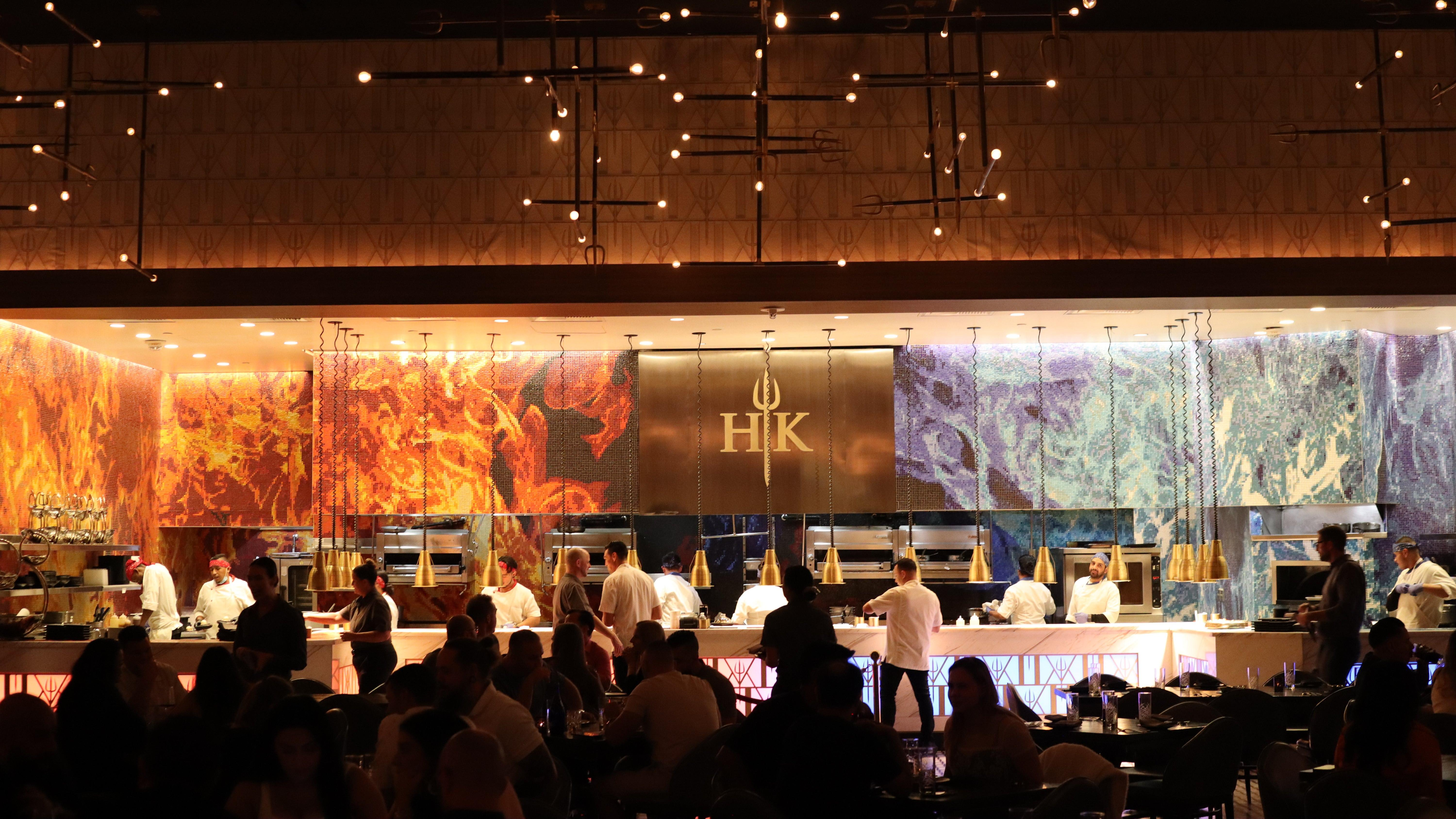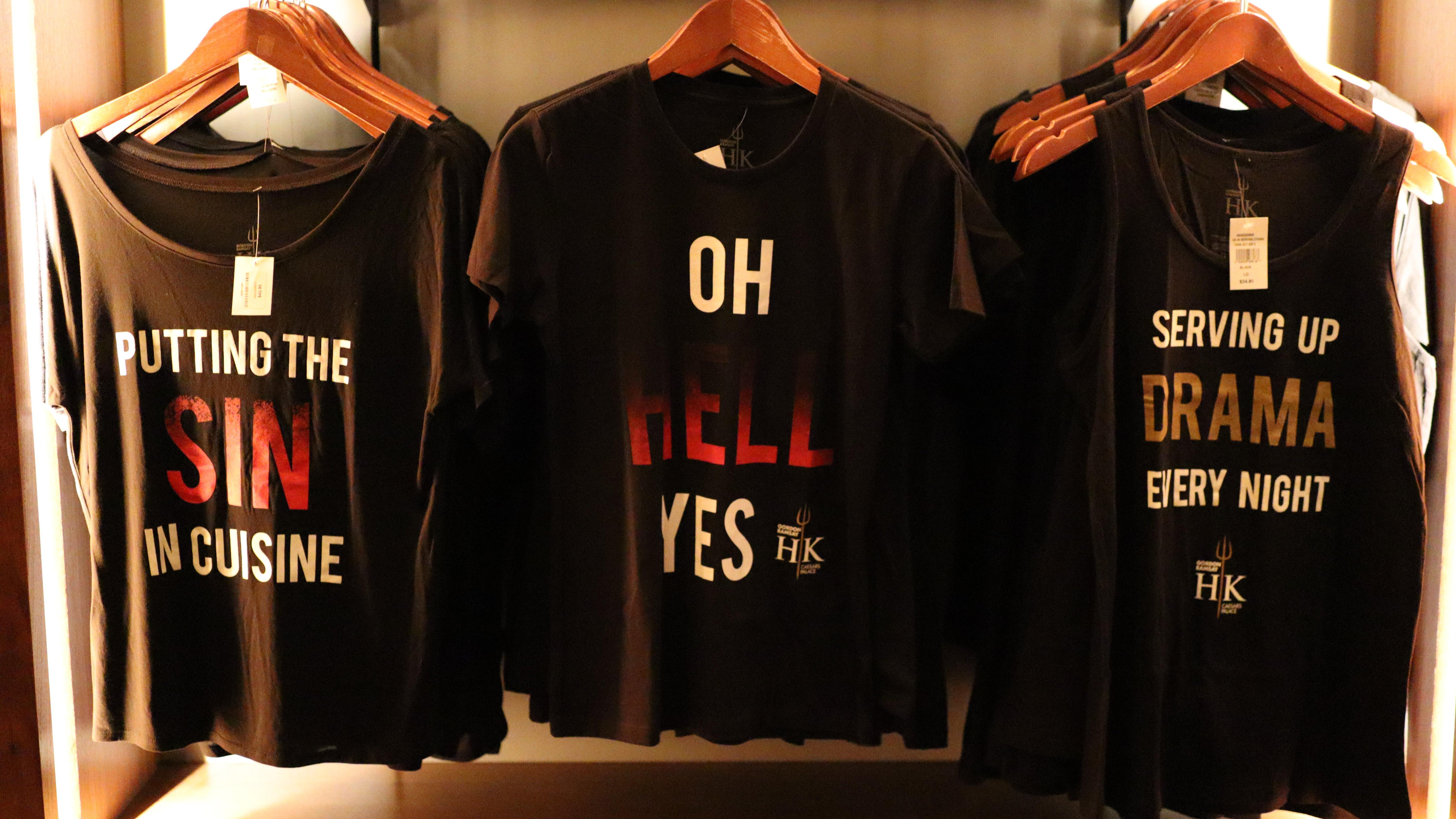My Night In Gordon Ramsay's Las Vegas Hell
Is dining at Hell’s Kitchen delicious or disturbing?
To be on the Las Vegas Strip is, to put it mildly, an overwhelming sensory experience. Bright lights that never stop glowing, cacophonous traffic and music, crowds surging 24 hours a day—but even among all of that, as I walked up to the stark, modernist building with flames erupting around the doors and a giant pitchfork gracing the entryway, I knew I was in for an unusually intense experience. Exactly what Hell's Kitchen hopes to provide.
What is Hell’s Kitchen?
Hell's Kitchen is one of Gordon Ramsay's five Las Vegas restaurants, located in front of Caesars Palace. The front windows overlook the Strip, but the real action is inside, in the bustling open kitchen where a huge culinary team churns out plate after plate of massive steaks.
As soon as I walked into the crowded dining room, I immediately felt a wave of hyper-focus wafting outward from the kitchen. I could practically hear Ramsay himself among them, shouting to the cooks that they should reconsider their life choices after undercooking/overcooking/slightly malforming a risotto, as he's done so many times on over 300 episodes of the restaurant's namesake television show.
The Vegas Hell's Kitchen opened in 2018, and there are now three other locations: Atlantic City, Lake Tahoe, and at a Harrah's casino in the desert just north of San Diego, appropriately near a place called Hellhole Canyon Preserve.
In the season 19 opener of Hell's Kitchen, which aired in early 2021, Ramsay brings the competitors to the Vegas restaurant, which was at that point the only location.
"This restaurant has been built on the reputation of 18 seasons of Hell's Kitchen," Ramsay said. "It's one of the highest grossing restaurants in America. The top three."
What it’s like dining in Hell’s Kitchen
The restaurant promises to make you feel like you're on the high-stakes competition show itself, and I have to say, it succeeds on essentially every level. The kitchen, with an overhead mosaic of rising red flames on one side and blue flames on the other, was brightly lit and full of activity on a busy Thursday night, with tables still being sat for dinner service past 10 p.m. There were flames rising up from the grills, foods being flipped in saute pans, and entrees being chopped or seared or seasoned, presented on platters accented with tridents that underscore the hellish theme of the place.
It's a great fit with the colorful schlock of the Strip; there are even decorative prop production lights around the dining room. In the entryway, there's a gallery wall of past Hell's Kitchen winners (some of whom are chefs at other Hell's Kitchen locations), and merch with phrases like "Oh hell yes" and "serving up drama every night."
But while Ramsay wasn't physically present when I dined at Hell's Kitchen, he was also everywhere—starting with my cocktail.
I ordered the Notes from Gordon ($20.95), with Plymouth dry gin, green tea, lemongrass, peach, lemon, and a "message from Gordon." All things considered, I would have rather had the Smoke on the Blvd ($21.95), made with Woodford rye, Aperol, Amaro Averna, and sweet vermouth, all smoked with cherry wood. But when a cocktail is offering a message from the celebrity chef most likely to make you cry over undercooked duck, how can you turn it down?
The message did not disappoint. Clipped to my cocktail was a rolled-up slip of paper bearing the Union Jack. When I unrolled it, the note read: "You've put so much ginger in this, it's a Weasley! -Gordon Ramsay."

In addition to the star power drawing people into the busy restaurant—I really can't emphasize enough how packed it was, more than any other restaurant I visited on my Vegas trip—another factor clearly contributes to the financial success of Hell's Kitchen: the high-roller prices of each and every menu item.
I ordered the Pan-Seared Scallops ($26.95) to start, with celery root, braised bacon lardons, and pickled granny smith apples. The sear on the scallops was absolutely perfect; I loved the combination of textures and flavors, the lardons lending the apples a pleasantly savory note. But I was surprised that the plate only had two scallops on it, sliced thin to make five pieces. The portion was enough food for an appetizer, but for the price, I would have expected one more scallop on the plate.

While Beef Wellington ($69.95) is Chef Ramsay's signature dish, I decided to treat myself in an even bigger way. After all, it's Vegas, right? I ordered the Mishima Reserve Wagyu Ribeye ($79.95) with glazed maitake mushrooms and shishito peppers. I normally prefer a leaner filet mignon, but this ribeye was beautiful: perfectly marbled and topped with luscious (dare I say silky?) sauteed mushrooms, finished with a red wine reduction. On the side, I ordered a pot of Potato Puree ($14.95) with creme fraiche and chives.
I was stuffed, but my server assured me I needed dessert, specifically the Sticky Toffee Pudding ($13.95), which is Chef Ramsay's specialty. He was absolutely right. The dish is similar to bread pudding, with an incredible depth of flavor in both the cake and the caramel draped over it. While the dulce de leche ice cream on top cut through the dense sweetness, I really wanted to focus on the cake itself, at least for as many bites as I could take before tapping out.

Ramsay's sixth Vegas restaurant is about to open on the Strip: Ramsay's Kitchen in Harrah's Las Vegas, which opens on November 17 and is designed to offer a more "personal" experience. While Hell's Kitchen immerses you in Ramsay's TV show, Ramsay's Kitchen promises a menu inspired by the chef's world travels and a feeling of being inside his home kitchen. It's similar in concept to Martha Stewart's new restaurant, The Bedford, which is in the Paris Las Vegas casino and is modeled after her farmhouse in upstate New York.
While the excitement of Hell's Kitchen was an experience I won't soon forget, next time I'm in Vegas, I think I'll go for a more laid-back night in Ramsay's Kitchen—and that Beef Wellington.

